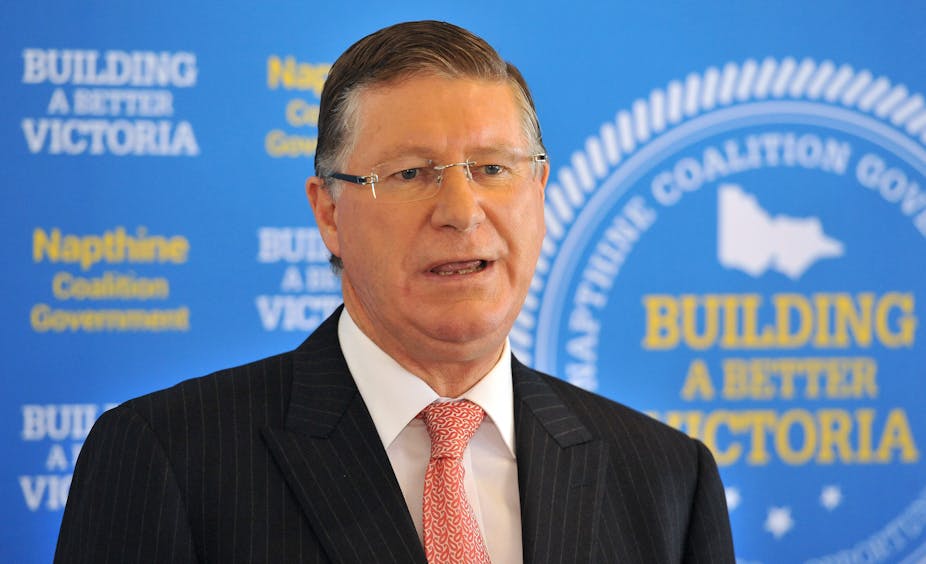The political crisis confronting the Victorian parliament is both curious and concerning. Since Denis Napthine took over as Victorian premier 15 months ago, the issue has steadily developed into an entirely foreseeable stalemate that now threatens his government.
Previously, Dustin Halse and I commented that the current threat to the stability of the Victorian parliament could have been avoided if the numbers in the Victorian legislative assembly had been adjusted at the time of constitutional amendment in 2003.
When the Bracks government legislated to introduce four-year fixed terms and codified the Westminster convention for dissolving the lower house through a successful no-confidence motion it created the conditions for the present impasse. Section 35(1) of the Victorian constitution provides that:
Victoria shall be divided into 88 districts each of which shall return one member to the Assembly.
This requirement is the primary factor that could potentially plunge the parliament into a hopeless deadlock.
The Liberal government formed under Ted Baillieu following the 2010 state election governed with the slim majority of 45-43. Once Liberal MP Ken Smith was elected as Speaker, the government held an advantage of one vote on the floor of the assembly.
However, in March last year, Geoff Shaw resigned from the parliamentary Liberal Party and withdrew his support for Baillieu, forcing his resignation as premier. Shaw’s move left the numbers on the floor of the house precariously placed at 43-43 with Shaw as the lone independent on the crossbench.
Napthine’s government received Shaw’s support in the lower house until late last year when allegations against Shaw of misuse of parliamentary entitlements came to a head. As a result of Smith referring Shaw’s alleged abuse of entitlements to the Victoria Ombudsman, Shaw declared a lack of confidence in Smith’s speakership.
Smith ultimately resigned as speaker in February. Less than a month later Shaw was forced to resign from the Victorian Liberal Party. To the shock and dismay of his colleagues, Smith reignited the issue last week by declaring that he would vote with Labor on any motion to find Shaw in contempt of the parliament.
In response, Shaw declared yesterday he will vote with Labor on any no-confidence motion in the Napthine government.
Napthine finds himself in the impossible situation where the fate of his government lies in the hands of an aggrieved Liberal MP and a former Liberal MP sitting on the crossbench.
Ordinarily, the opposition would have already moved a motion of no-confidence in the government. However, if Labor leader Daniel Andrews moves a no-confidence motion it will require the vote of Shaw. Labor appears reluctant to accept Shaw’s vote, having said previously that it would not do so. Andrews has said that Labor’s preferred option is the expulsion of Shaw from parliament.
In a press conference late last night, Andrews said Labor would agree to support the passage of the state budget on the condition that Napthine agreed to meet Andrews and Victorian governor Alex Chernov to seek advice on the impasse. Napthine is refusing to accept that condition.
Alternatively, Napthine can attempt to continue governing and leave the ordinary business of the lower house at the whim of Shaw, who has previously used his vote to frustrate the government. This also leaves Shaw open to a motion of contempt being moved against him for misusing his parliamentary entitlements.
The result of such a motion passing, with Smith’s support, would inevitably see Shaw lose his seat in the parliament. That would probably force an early by-election in his seat of Frankston and likely result in further instability. Alternatively the seat of Frankston could be left vacant until the date of the state election, an undesirable outcome for the seat’s constituents.
Whatever course Napthine chooses, he has effectively lost control of the government. This is an unattractive look months out from the state election, scheduled for November 29.
It is unfortunate that these potential issues were not more carefully considered at the time of constitutional amendment in 2003. A practical solution would have been to alter the number of assembly seats to an odd number, which applies in every other state lower house. However, following the 2003 reforms, the numbers of the assembly can be altered only through a referendum.
Further reading: The constitutional implications of Victoria’s ‘crisis’

